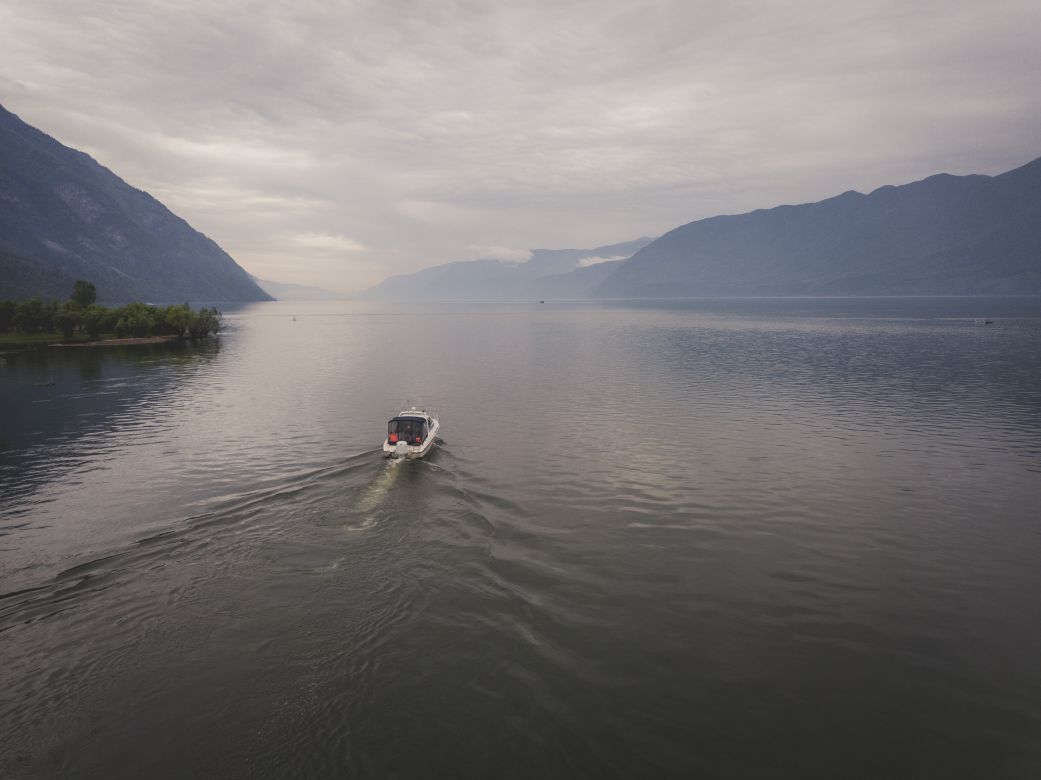Travels
Scenic Tours
How to return to the touristy Altai from the authentic Altai, who to buy Qurut and kospa from, and where to wake up as a new person.
The journey begins on the southern shore of Lake Teletskoye, on Cape Kyrsay. In a way, this is the entrance to another Altai – one with a perceptible tourist flavour, radiating the traditional Soviet neglect towards fellow man. While the lack of sockets, power, and running water at Stone Mushrooms is compensated by the use of generators and all-pervading hospitality of the owners, either would be hard to come by in Kyrsay. At local tourist campsites, even a rubbish bin discovered with considerable difficulty can become a bulwark of comfort. Private toilets, of which there are none – we’ve checked – exacerbate the situation somewhat. But crossing Lake Teletskoye is definitely worth the mild humiliation, and you can look the other way for one night.

Lake Teletskoye
One of the deepest lakes in Russia, Lake Teletskoye is on the UNESCO World Heritage List – and is, quite fittingly, nicknamed ‘little Baikal’. It is situated at the same latitude as the southwestern part of Lake Baikal, and its aquatic area above sea level falls only twenty meters lower than that of Baikal. These cornerstones of domestic tourism are also related to each other through similar climates, landscapes, the flora, and the fauna scattered on the slopes of the surrounding valleys.
The lake owes its Russian name to the domestic explorers who christened it after the Altai tribe of Tyolyos that used to settle on its shores – but for local peoples, it is still Altyn-Kohl, ‘Golden Lake’. At this point, every local guide will start spinning a yarn about either a shepherd, or a hunter, called Chokul who, in a lean year, tried to exchange a gold nugget the size of a MacBook Air (God knows where he got it) for food. He failed to find a buyer as no one could boast excess food that year. Utterly disheartened, he threw his useless nugget into the lake, thereby giving it its name.

From Kyrsay to Artybash
Crossing Lake Teletskoye is a grand-scale undertaking, comparable to driving along the Chuya Highway in its meditativeness and absolutely beyond comparison when it comes to the beauty of the landscape. The nature reserve status and low population density of the area have kept the local nature intact. The uniqueness of the scenery lies in the captivating combination of alpine relief with a deeply cut basin of Scandinavian-like clean and cold water. The lake is framed by severe-looking crags and wide bays opening into a few smaller coves. During your leisurely glide in a ferry, make sure to take in the resplendent views: of the lush apple and pear orchards laid out on the lake terraces by the village of Bele; of the Yailu Natural Reserve estate; and the picturesque Korbu Waterfall. To be fair, storms causing waves the height of a grown man aren’t a rare occurrence here, so make sure to appease the spirits while still on the shore.

Life Hack
A car space on a small, four-vehicle ferry will cost you 15k rubles, and the crossing will take approximately five hours. Upon getting to Artybash, feel free to dive straight into the bliss of civilization at Chalet Teletskoye. The cosy cabins on the lake shore boast not only private showers and toilets but also panoramic windows, which makes going to bed and waking up in this place a pleasure in itself.
Artybash
This well-tended lake village is an extremely touristy place, and there is no point in lingering here. But before leaving, make sure to visit Synaru Anatpaeva at Altai Ail, a museum of Altai life. While working on opening her own museum, Synaru lovingly put together a collection of handmade items by Altai craftsmen, painstakingly studied the history and philosophy of her people, and had thoughtful conversations with shamans. The museum looks like a traditional ail.
It must be noted that an ail is not an ordinary yurt: it resembles a diamond in shape, and, in essence, it connects three worlds: the lower, the middle and the upper ones. For a modern Altai person, an ail is not just a nod to tradition or an ordinary house – it is the very castle that protects the whole family. There is a hearth in the middle of the room and the front door – low, with a high threshold – always faces the sun, so those who enter bow to the fire, and those who leave – to the sun or the moon. The left-hand part of the ail is historically considered male (the sun enters the ail from the right), whereas the right-hand side is female (moonlight shines on it first). Behind the hearth, there is a sleeping area with a bed, a cradle, and an indispensable dowry chest. Altai babies come into this world on a parental bed, and, therefore, this is the most protected place in the ail: its first defence is the hearth, second – the threshold, third – the hitching post outside, fourth – the hitching post by the fire, and the fifth line of defence is the canopy over the bed.
Everything is exactly that way in Synaru’s ail, and all traditional gender attributes are represented in its right and left parts: from a bow with arrows to a stone-cutter to a vessel for storing chegen, the Altai fermented milk, which Synaru generously offers her guests. There’s a distillation apparatus for homemade arachka that is definitely worth a try, especially, when spiced up by Synaru’s fascinating tales. She’ll also treat you to local specialities: Qurut (round chunks of drained yogurt or sour milk, also known as kashk in the East), pastrami-like beef, kospa (sweets made from barley flour, better known as jent), and baursaks (or Boortsog, Altai fried dough pies).




 7 min
7 min